
Absente is a brand name of 110 proof anise liqueur that has been marketed under the tagline "Absinthe Refined" since c. 2000. "Absente" is a French word that translates as "absent" in English.

Absente is a brand name of 110 proof anise liqueur that has been marketed under the tagline "Absinthe Refined" since c. 2000. "Absente" is a French word that translates as "absent" in English.
Prior to 2009, Absente sold in the U.S. contained no grande wormwood (Artemisia absinthium), [1] the essential herb from which absinthe derives its name. The maker substituted southernwood ( Artemisia abrotanum ) and the product was bottled with sugar, two critical aspects that differentiated Absente as an anise liqueur and not an absinthe by any traditional reference. The ingredients of Absente are listed in order as alcohol, sugar, a combination of "essences", infusions and distillates, [2] and two artificial dyes, FD&C Yellow #5 and Blue #1. [3]
Absente's U.S. marketing effort had long sought to associate the liqueur with traditional absinthe through statements such as, "The only difference is we replaced Wormwood...with a less bitter cousin called Southern-Wormwood, also known as "Petite Absinthe," which allows us to offer Absente in the United States." [4] The reference to "petite absinthe" is inaccurate, as petite absinthe refers invariably to 'Roman wormwood' ( Artemisia pontica ) [5] throughout credible distillation treatises, [6] while 'southernwood' is historically referred to as aurone, abrotone, or armoise citronelle, [7] and is scarcely ever mentioned, if at all. At that time, Absente's website explained, "By maintaining a form of wormwood in Absente, we are able to truly call Absente a modern Absinthe."
Following the re-legalization of genuine absinthe in the U.S. in 2007, [8] the North American importer introduced a reformulated version that includes grande wormwood (April, 2009) [9] in an apparent effort to improve its consumer appeal. The new label proclaims, "Now With Wormwood!". Since 2016 it has been marketed as “traditional absinthe with wormwood”
The version marketed in Europe under the same name is and has always been made with "essence of grande wormwood" (Artemisia absinthium). [2] The label design differs mildly from the U.S. version by having "Liqueur aux Plantes d'Absinthe" above the main label and a silver capsule.
Wormwood may refer to:
Herbsaint is a brand name of anise-flavored liqueur originally created as an absinthe-substitute in New Orleans, Louisiana in 1934, and currently produced by the Sazerac Company.
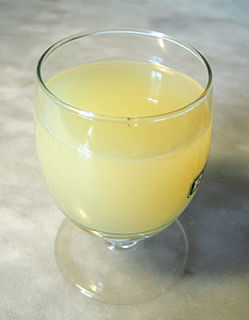
Pastis is an anise-flavoured spirit and apéritif traditionally from France, typically containing less than 100 g/l sugar and 40–45% ABV.
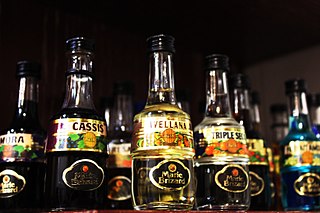
Anisette, or Anis, is an anise-flavored liqueur that is consumed in most Mediterranean countries. It is colorless, and because it contains sugar, is sweeter than dry anise flavoured spirits. The most traditional style of anisette is that produced by means of distilling aniseed, and is differentiated from those produced by simple maceration by the inclusion of the word distilled on the label. And while Pastis is a similar-tasting liqueur that is prepared in similar fashion and sometimes confused with anisette, it employs a combination of both aniseed and licorice root extracts. Sambuca is essentially an anisette of Italian origin that requires a high minimum (350g/l) sugar content.

Artemisia is a large, diverse genus of plants with between 200 and 400 species belonging to the daisy family Asteraceae. Common names for various species in the genus include mugwort, wormwood, and sagebrush.
Pernod Fils was the most popular brand of absinthe throughout the 19th century until it was banned in 1915. During the Belle Époque, the Pernod Fils name became synonymous with absinthe, and the brand represented the de facto standard of quality by which all others were judged.
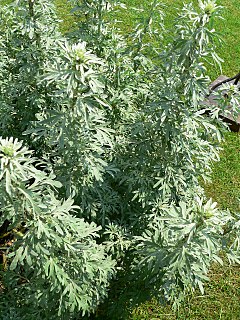
Artemisia absinthium is a moderately poisonous species of Artemisia native to temperate regions of Eurasia and North Africa, and widely naturalized in Canada and the northern United States. It is grown as an ornamental plant and is used as an ingredient in the spirit absinthe and some other alcoholic beverages.
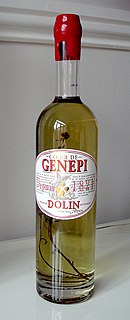
Génépi or génépy or genepì is a traditional herbal liqueur or aperitif popularized in the Alpine regions of Europe. Genepi also refers to alpine plants of the genus Artemisia that provide the liqueur's flavor and color, and the French Savoy region adjacent to the Aosta Valley, where the Artemisia genepi plants grow and where the beverage is commonly produced.
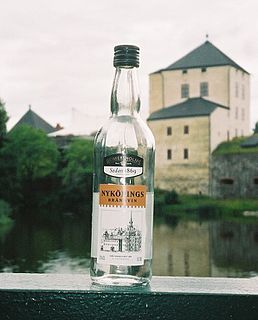
Brännvin is the Swedish term for liquor distilled from potatoes, grain, or (formerly) wood cellulose. It can be plain and colourless, or flavoured with herbs and spices. The term includes vodka and akvavit, but akvavit is always flavored. Beverages labelled brännvin are usually plain and have an alcohol content between 30% and 38%. The word brännvin means "burn[t] (distilled) wine". It is cognate with English brandy[wine], Danish brændevin, Dutch brandewijn, German Branntwein, and Icelandic brennivín. A small glass of brännvin is called a snaps, and may be accompanied by a snapsvisa, a drinking song.
La Fée Absinthe is a brand of absinthe; it is a highly alcoholic, distilled spirit containing the herb wormwood. La Fée Absinthe was created by Green Utopia, which is owned and run by George Rowley.

Mugwort is a common name for several species of aromatic flowering plants in the genus Artemisia. In Europe, mugwort most often refers to the species Artemisia vulgaris, or common mugwort. While other species are sometimes referred to by more specific common names, they may be called simply "mugwort" in many contexts.
Flavored liquors are liquors that have added flavoring and, in some cases, a small amount of added sugar. They are distinct from liqueurs in that liqueurs have a large sugar content and may also contain glycerine.
La Clandestine Absinthe is a Swiss La Bleue, or clear, absinthe brand produced by Artemisia-Bugnon distilleries. It is an anise-flavored, distilled liquor containing the herb wormwood, and when prepared with cold water will louche. La Clandestine Absinthe comes in four main styles, as detailed below.
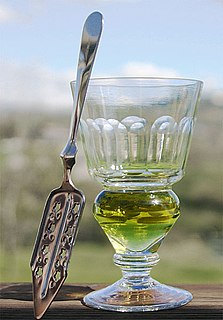
Absinthe is an anise-flavoured spirit derived from several plants, including the flowers and leaves of Artemisia absinthium, together with green anise, sweet fennel, and other medicinal and culinary herbs. Historically described as a highly alcoholic spirit, it is 45–74% ABV or 90–148 proof US. Absinthe traditionally has a natural green color but may also be colorless. It is commonly referred to in historical literature as la fée verte. It is sometimes mistakenly referred to as a liqueur, but is not traditionally bottled with added sugar and is, therefore, classified as a spirit. Absinthe is traditionally bottled at a high level of alcohol by volume, but it is normally diluted with water before being consumed.
Lucid Absinthe Supérieure is the first genuine absinthe made with real Grande Wormwood to be legally available in the United States after the repeal of the 95-year ban.
Kübler Absinthe Superieure is a brand of absinthe, distilled in the Val-de-Travers region of Switzerland also known as the "birthplace of absinthe". Kübler Absinthe was first produced in 1863 and was the first brand to be sold legally in Switzerland after the national ban on absinthe was lifted in March, 2005. The legalization of absinthe in Switzerland is largely due to Kübler's lobbying efforts. The United States Alcohol and Tobacco Tax and Trade Bureau (TTB) approved the formula for Kübler Absinthe in 2004, and approved the product for sale in the United States in May 2007 after three years of discussions among Kübler, Food and Drug Administration, TTB, and U.S. Customs and Border Protection. These discussions proved to be instrumental in opening the door for many brands of absinthe to be legally sold or produced in the United States.
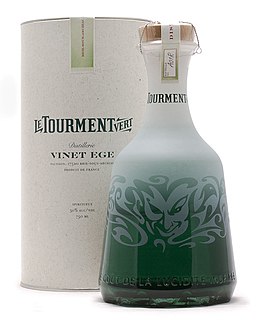
Le Tourment Vert was an absinthe-like liqueur imported from the French Distillerie Vinet EGE, near the French commune of Cognac. The spirit was created in 2007.

Absinthin is a naturally produced triterpene lactone from the plant Artemisia absinthium (Wormwood). It constitutes one of the most bitter chemical agents responsible for absinthe's distinct taste. The compound shows biological activity and has shown promise as an anti-inflammatory agent, and should not to be confused with thujone, a neurotoxin also found in Artemisia absinthium.

Artemisia cana is a species of sagebrush native to western and central North America, a member of the sunflower family. It is known by many common names, including silver sagebrush, sticky sagebrush, silver wormwood, hoary sagebrush, and dwarf sagebrush.
| Wikimedia Commons has media related to Absente . |